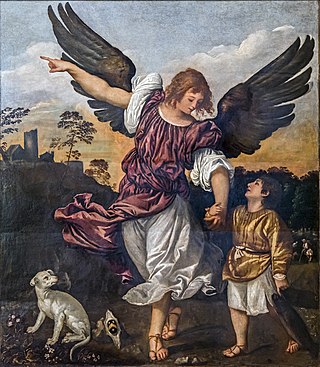
Lorenzo Lotto was an Italian Renaissance painter, draughtsman, and illustrator, traditionally placed in the Venetian school, though much of his career was spent in other north Italian cities. He painted mainly altarpieces, religious subjects and portraits. He was active during the High Renaissance and the first half of the Mannerist period, but his work maintained a generally similar High Renaissance style throughout his career, although his nervous and eccentric posings and distortions represented a transitional stage to the Florentine and Roman Mannerists.

Cain and Abel is an oil painting by the Venetian painter Titian. It was made in about 1543–1545 for the church of Santo Spirito, but is now in the basilica of Santa Maria della Salute.

Abraham and Isaac, also known as the Sacrifice of Isaac, is an oil painting by the Venetian painter Titian. It was made in about 1543–1544 for the church of Santo Spirito, but is now in the basilica of Santa Maria della Salute.

David and Goliath is an oil painting by the Venetian painter Titian. It was made in about 1542–1544 for the church of Santo Spirito, but is now in the basilica of Santa Maria della Salute.

Salome, also known as Salome with the Head of John the Baptist, is an oil painting by the Venetian painter Titian, made in about 1550, and currently in the collection of the Museo del Prado in Madrid. It is not to be confused with other compositions of Salome and Judith by Titian.

Girl with a Platter of Fruit, also known as Lavinia Holding a Charger Filled with Fruit, Lavinia as Flora, and Pomona, is an oil painting by the Venetian painter Titian, made in about 1555–1558, and currently in the collection of the Gemäldegalerie, Berlin.

Portrait of a Man in a Red Cap, also known as Man with a Red Cap, is an oil painting by the Venetian painter Titian, made in about 1516. It is part of the Frick Collection in New York City.

Sisyphus is an oil painting by the Venetian master Titian, made in 1548 or 1549. It is in the collection of the Museo del Prado in Madrid.

Portrait of Jacopo Sannazaro, also known as Portrait of a Man, is an oil painting by the Venetian master Titian, dated to about 1513. It is part of the Royal Collection, and hangs in Buckingham Palace.

Portrait of the Physician Gian Giacomo Bartolotti da Parma, also known as Portrait of a Man, is an oil painting by the Venetian master Titian, made c. 1515-1518. The painting is in the collection of the Kunsthistorisches Museum, in Vienna.

Nymph and Shepherd, also called Shepherd and Nymph, is an oil painting by the Venetian master Titian, made about 1570. The painting is in the collection of the Kunsthistorisches Museum in Vienna.

Portrait of John Frederick I, Elector of Saxony is an oil painting by the Venetian painter Titian, made in late 1550 or early 1551. The painting is in the collection of the Kunsthistorisches Museum in Vienna.

The Archangel Raphael and Tobias is an oil painting by Titian of Tobias and the Angel, dated to about 1512 to 1514, which is now in the Gallerie dell'Accademia in Venice. Another painting by Titian of the same subject, entitled Tobias and the Angel, dated to about 1540 to 1545, remains in the church of the Madonna dell'Orto in Venice.

The Ecce Homo is a large oil painting by Titian, signed and dated 1543, which hangs in the Kunsthistorisches Museum in Vienna. It is not to be confused with several smaller compositions by Titian.

Portrait of Benedetto Varchi, also called Portrait of a Man, is an oil on canvas painting by Titian. It was painted c. 1536-1540, and hangs today in the Kunsthistorisches Museum, in Vienna.

Portrait of Fabrizio Salvaresio is an oil painting by Titian. It is signed and dated 1558, and hangs today in the Kunsthistorisches Museum in Vienna.

Portrait of Cardinal Cristoforo Madruzzo is an oil painting by Titian, signed and dated 1552, which hangs in the São Paulo Museum of Art.

The Baptism of Christ is a religious painting by Titian, dated to about 1512, in the collection of the Capitoline Museums, Rome.

Portrait of Count Antonio Porcia and Brugnera is an oil painting by Titian, dated to c. 1535-1540. It hangs in the Pinacoteca di Brera, in Milan.

Portrait of Doge Andrea Gritti is an oil painting by the Venetian master Titian, painted in the late 1540s, which is part of the collection of the National Gallery of Art in Washington, D.C. It is a portrait of Andrea Gritti, who was doge of Venice from 1523 to his death in 1538. A posthumous portrait, it is likely based on earlier depictions of the Doge, including one executed by Titian between 1537 and 1540 for Sala del Maggior Consiglio and destroyed during a fire in 1577.




















